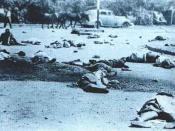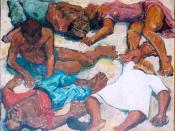South Africa Coursework1.Study Sources A & B-How far do these sources agree about what happened in Sharpeville?Source A is a journalist (Humphrey Tyler); Tyler was a journalist for a South African newspaper. Tyler was unique in being the only journalist in Sharpeville on the day of the massacre; this makes Tyler a primary source. TylerÃÂs account seems to be of the opinion that the police over-reacted.
Source B is a report in an English newspaper. The report was published the day after the Sharpeville massacre making it a secondary source. Source B clearly gives the impression that the police were being threatened and besieged by the protesting Africans.
Both sources agree on a number of points. For example, both sources agree on the presence of Saracen armoured cars in the township, ÃÂDriving behindÃÂ three Saracen armoured carsÃÂ ÃÂ Source A, and ÃÂabout a dozen Saracens were at SharpevilleÃÂ - Source B, the sources also agree that there were protesting Africans chanting at the police.
Source A states ÃÂmany people were shoutingÃÂ, and source B says ÃÂthousands of Africans shoutingÃÂ.
Similarly, both sources also agree that the protest had grown into a large crowd, and also that there had been a large mobilisation of police in response to the crowds. Both sources also mention a concentration of police strength. Source A says ÃÂPolice too, well armedÃÂ while Source B says that ÃÂPolice reinforcements were sentÃÂAfter this, however the sources begin to diverge. Both sources claim that the crowd was chanting a different slogan. Tyler claims that the demonstrators were chanting the slogan of the P.A.N ÃÂ ÃÂIzwe LethuÃÂ (trans. ÃÂOur LandÃÂ); while Source B says that the protestors were crying ÃÂAfrica! Africa!ÃÂ also, the English newspaper reports that there were earlier disturbances in the township (culminating in the shooting dead...


![[Hank Gowdy, Dick Rudolph, Lefty Tyler, Joey Connolly, Oscar Dugey (baseball)] (LOC)](https://s.writework.com/uploads/12/122849/hank-gowdy-dick-rudolph-lefty-tyler-joey-connolly-oscar-dug-thumb.jpg)